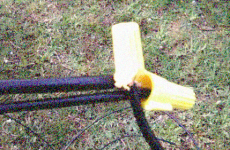In the previous posts by setting up a good dipole I confirmed:
I have a good coax/ connector, I have a working SWR meter, I can somewhat measure things.
Now to answer the question about matching a long wire to a VHF set.
What is a long wire antenna?
According to the US Marine Field antenna manual it is a directional pattern antenna and primarily transmits or receives HF signals. Consisting of a single wire, preferably two or more wavelengths supported off the ground 10 to feet. Connect the far end of the wire to a ground through a non-inductive 500-600 ohm resistor (rated for the power). Use ground rods or a counterpoise.
I don't think a long wire antenna is the right choice for being directional on VHF. The polarization is mostly horizontal. It also has complex impedances that are tricky to match to the radio.
The first posters question was how you get the 522 to match the long wire, and I've found one way (not saying it's good or that you should do this!

).
Some search-engine-fu reveals that you should use a 9:1 impedance transformation for a long wire antenna. How the hell does a person do that in the field? I did find a video explaining how to create an air-core 4:1 impedance matching device.
https://www.youtube.com/watch?v=7lYY7nkKrWo
The drawing in the video is incorrect, it should be:
[Capture]

Note: Impedance is just a fancy word for resistance at a certain ac frequency.
So I built it with some wire I had laying around with a piece of wood about the size of the pipe in the video...
[Balun]

[BalunSWR]

Expecting loss the higher it gets in frequency.
The radio impedance 50 ohms, the coax 50 ohms, balun 4:1, then I attach 200ohm resistor (two 100 ohm resistors in series) on the output of the balun to test it.
[Balun200Ohms]

[Balun200OhmsSWR]

Almost perfect!!! 200/4 = 50. So 50/50/50 is a match giving us a SWR near 1!!! This stupid thing just might work!
I then attach a resistor of 50 ohms (two 100 ohm resistors in parallel), the SWR goes up to 3, makes sense, we no longer have a match.
[Balun 50 Ohm Load]

[Balun 50 Ohms SWR]

(Dipoles are typically 30 to 80ohms impedance, which is why you can get away without worrying about impedance with coax)
Time to test this in the field!
[Long Wire]

[LongWirePicture] (Can't see the resistor)

So I did my best to set up a long wire antenna. But I grabbed the wrong reels of wire so I only had about 2x ~30 feet of wire.
I set it up the best I could to match the mil manual picture.
I built my own high power non-inductive resistor. Take a container, have two wires almost (but not) touching in a container. Add enough warm water to cover it (about 200mL in this case). Add a sachet of salt. Shake. Serve. Makes 1 high power resistor between 500-1500ohms. Add water as it boils off

[HighPower Resistor 1Kohm]

The results:
With ~40 feet of RG-58 coax, going in to an ugly choke, in to the long wire:
[LongWireNoBalunSWR]

I consider any SWR over 3 unusable.
And with the 4:1 AirBalun stuck between the ugly choke and long wire?
[LongWireBalunSWR]

Not great, not terrible

. Under 3 SWR for a fair bit of of the VHF spectrum.
If I ever get a chance, I'll try this with WD Wire.
Yes, the radio will happily transmit into this "long wire" while using this air core balun on frequencies over 35MHz.
Will it be efficient? probably not. Is some/ most of the signal being lost? Does it matter? Further testing required!
Although, the horizontal long wire can be good for HF, I really don't see it being that great for VHF. I see the YAGI being more practical in the field.
I'm going to continue editing this post as I upload the pictures and correct this.
Also, I'm re-reading this and seeing how poorly it conveys information to my intended audience (somebody who might have to use this in the field). I will re-write this later because it's kinda crappy.





















